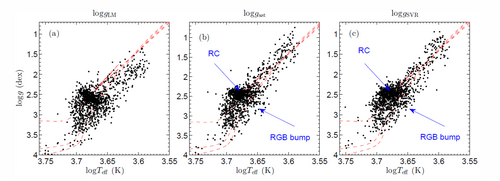NAOC Researchers estimate the surface gravity for the LAMOST red giant Stars
Dr. Chao Liu et al. recently employ about 1500 LAMOST-Kelper common red giant stars to re-calibrate the surface gravity (logg) with the seismic values using a noval technique called the support vector machine. They found that the accuracy of the new calibrated logg is about 0.1 dex, a factor of 2 better than the original logg values provided by the LAMOST pipeline. This can improve the uncertainty of the distance estimate by 12%. This study has been published in The Astrophysical Journal (2015, ApJ, 807, 4L).
The asteroseismology studies about the oscillations, like the earthquake, in the surface of stars. ?Astronomers have found that the oscillation patterns of a solar-like star are tightly correlated with the mass, radius, and the surface gravity. The accuracy of the estimation of these fundamental parameters from the asteroseismology are much more accurate than those from other techniques. For instance, the surface gravity (logg) measured from seismology can be as accurate as 0.01-0.02 dex, about an order of magnitude better than that measured from the high resolution spectroscopic data. Kepler satellite project has provided the asteroseismic measurement for about 15 thousands giant stars and solar-like stars. However, asteroseismic survey in a broader sky area are very expensive and not yet achieved.
The effective temperature vs. surface gravity about 1352 red clump samples are shown below. This figure demonstrates the LAMOST logg (left panel), the Kepler seismic logg (middle panel), and the new derived logg from the support vector machine (right panel). It is seen that the new logg is much better than the original LAMOST values, highly in agreement with the seismic values.
LAMOST DR2 data contains about 400 thousands metal-rich giant stars, which logg can be well recalibrated with the accurate seismic logg values provided by Kepler data. The recalibration gave better estimation of logg, which is critical for the distance and age determination of the stars and hence very important for the study of the Milky Way. Moreover, the new estimated logg is well consistent with the synthetic isochrone, especially the stellar distribution in the red clump. The primary and secondary red clump stars can be well distinguished and even the red bump stars can be identified.
